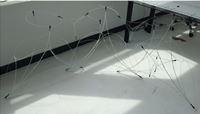Form-Finding of an Ecological “Green” Wall Using Bending-active Biotensegrity Structure

Three case studies were completed in this study, which include a static bending-active Textile Hybrid M1 at La Tour de 1’Architecte designed by ICD/ITKE, a bending-activated tensegrity structure designed by Technische Universität München, and a bending active tensile membrane hybrid tower designed by CITA and KET.
Based on the findings, principles for a new type of bending-active structure with biotensegrity logics are formulated through systems thinking to address its function, architectural form-finding, and structural stability. A pre-stressed and self-stabilized ecological ‘green’ wall prototype was designed and built using elastically bent glass fiber reinforced plastic (GFRP) rods in combination with flexible and expandable connections. The new adaptive and dynamic structural form, coupling bending-active systems with biotensegrity logics, explores the opportunities of elasticity, resiliency, and strength within a self-supporting structure. This study presents the design, material selection, and iterative form-finding of the wall prototype.
The GFRP bending rods play an important role in the structural system and need to be carefully arranged and connected to carry the loads transferred from the plants and to enhance the rigidity and stability of the structure.
keywords: Form-finding; bending active; biotensegrity


Add comment
Log in to post comments